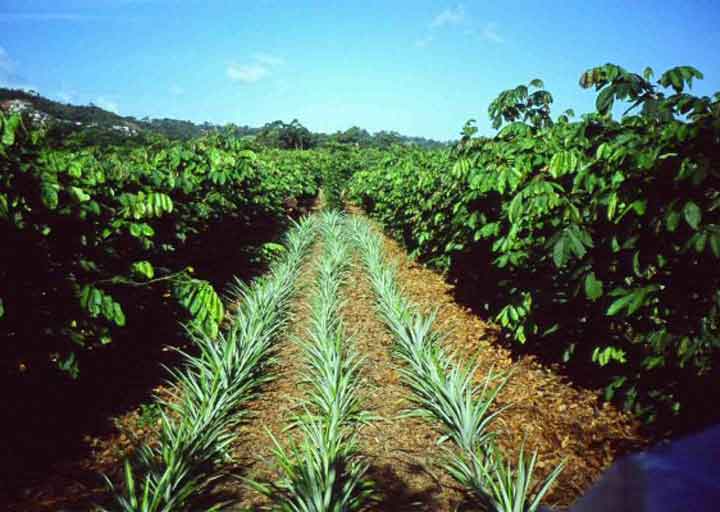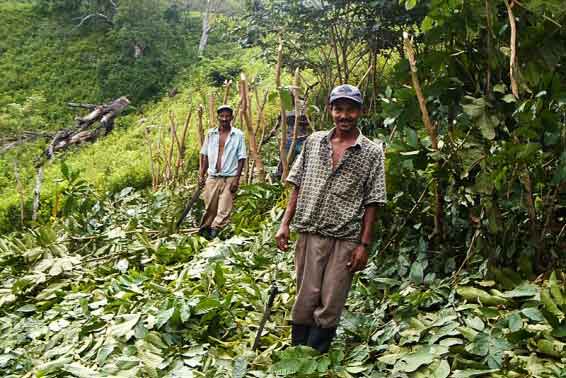Inga alleys, a farming technique that helps restore degraded lands
This article was written by Lorraine Potter of the Inga Foundation. Translated by Forests News.
Five years ago, the Honduran farmer Damas Nunez had reached a point of economic desperation and decided that the best option he had to feed his family was to flee north to the United States, despite the risks that that implied.
He paid a farewell visit to a friend who had a farm in the upper Cangrejal Valley and was surprised to see a beautiful corn crop and a large pile of firewood, enough for a year.
His friend Eli Cruz had implemented a new agroforestry system known as Inga alley cropping which was introduced in Honduras by the Inga Foundation. The technique had completely transformed Eli’s lands, providing him with improvements.
Damas then visited the Inga Foundation model plot, obtained his own seeds to grow, and the team showed him how to revitalize his degraded land by planting Inga edulis hedgerows. Today, Damas has cash crops for sale and food security.
Since 2012, Inga Foundation’s innovative agroforestry system has radically transformed the lives of 300 families in Honduras who practice subsistence agriculture, planting more than 3 million trees and becoming a true model of environmental sustainability and ecological resilience.
Damas and his family followed in the footsteps of 40 families who in 2012 planted half of their land – less than one hectare in size – with Inga alleys and the other half with traditional cultivation techniques. That year, Central America was hit by a severe drought, followed by torrential rains, and families feared their crops would be lost.
However, the Inga trees proved their resilience. There were only a few losses, and although the crops planted between the alleys produced modest harvests, they had an essential source of food amid the precariousness. The farmers noted that their plots cultivated with shifting cultivation techniques had produced nothing and the soil had been swept away, while their first alley crops in Inga had yielded a harvest.
The fast-growing, native Inga edulis is the main tree species, but other indigenous species are also used. In total, the Inga team has planted 3 million trees since 2012 – the nurseries have produced 250,000 cacao, rambutan, citrus, avocado plants and 75,000 black pepper plants. And more than 100,000 hardwood tree seedlings have been distributed. Species include mahogany (Swietenia macrophylla), black laurel (Cordia megalantha), walnut (Juglans olanchana), and marapolán (Guarea grandifolia). In 2019, plum (Astronium graveolens), granadillo (Dalbergia spp.) And 70 thousand round seedlings (Magnolia yoroconte) were included in the distribution, which is considered highly vulnerable.
The Inga alley cropping method, in alleys formed by Inga trees, is based on more than 25 years of research and trials at the University of Cambridge by the founder and director of the Inga Foundation, the tropical ecologist Michael Hands. His research focuses on agricultural techniques that protect the land from degradation. Using the traditional method known as shifting cultivation or, previously, “slash and burn” to prepare the land for planting, the land becomes infertile, overgrown, eroded, and leaves farmers with limited acreage to they do not produce healthy crops. Previously, farmers then chose to move to another plot.

Pineapple plantation. Photo: Inga Foundation
Currently, with the implementation of the Inga alley cropping method, families obtain “land for life”, the ability to remain on the same plot of land indefinitely and to regenerate steep or degraded lands that have been abandoned as “barren” for more than 50 years.
Hands and a Honduran team of forestry engineers, agronomists, and field and nursery personnel have promoted the Inga alley cropping method in 15 countries, including Honduras, with training and provision of seeds at zero cost.
The model that uses Inga trees is not only an alternative to shifting cultivation, it is also the solution to stop it. Very rarely has a simpler and more successful solution been found for the world’s most serious problems.
Now, in the 9th year of the 10 years of the “Tierra de por vida” program in Honduras, the Inga alley cropping model is on the rise and more than 200 families are on the waiting list for seeds and training to enable them to do so. their own “Inga alleys”.
The fast growing, wide variety Inga (over 300 species) is easy to germinate, resistant to disease, can thrive on steep and degraded slopes and survive both 7 months of drought and 8 inches of rain in 18 hours .
When Inga trees are 10-15 feet tall, they are pruned to a certain height, the leaves are pulled off and used as compost, and the branches become precious firewood. Trees need only an occasional coating with “K-Mag” fertilizer and PR, through which (and with Cambridge University research of over 15 years in pilot plots) Hands solved the soil problem by discovering that the lack of availability of phosphorus in the soil was the key.
The sun has more option to reach the seeds of corn or beans that are planted between rows of trees; and when its season ends, the Inga sprouts again and the cycle repeats itself. The program creates an integrated ecosystem that provides an organic and resilient livelihood for farming families in the tropics, to achieve food security while protecting wildlife habitats, water sources, and improving soils.
The program creates an integrated ecosystem that provides an organic and resilient livelihood for farming families in the tropics, to achieve food security while protecting wildlife habitats, water sources, and improving soils.
Inga alley cropping addresses:
- Food security: 100% of families with crops in alleyways of Inga (between one and a half and two years) achieved food security.
- The unsustainability of slash-and-burn agriculture and the prevention of involuntary fires.
- Capture or storage and avoidance of carbon emissions (180,000 tons from 2012 to 2019).
- Regeneration of degraded land: steep, barren, or abandoned land greened between a year and a year and a half – 2,500 acres between 2012 and 2019 -.
- Improved nutrition and reduced growth stunting: all crops and grains are organic (black pepper, turmeric, pineapple, allspice, rambutan (lychee), citrus, cocoa, vanilla).
- Protection of watersheds: rivers, ocean and reefs Improvement in rural livelihoods: cash crops, absence of debts or loans in families.
- Elimination of erosion and landslides.
- The provision of renewable firewood from annual pruning, without cutting down forest trees.
- Reducing migration to cities and climate refugees.
- Elimination of herbicides and pesticides.
- The elimination of the use of fertilizers and chemical inputs, of genetically modified seeds and heavy machinery.
- The whole family work together – close to home – and without the need for technology.
- Resistance to climatic effects – families grow beans or corn without irrigation or rain, since the organic debris cover keeps the soil fresh and retains water.
- The fulfillment of 11 of the 17 Sustainable Development Goals of the UN in a positive way, without any negative impact on the others.
The regeneration of steep and degraded lands is the biggest and lowest cost opportunity for forest landscape restoration and carbon recovery: eroded and barren land is restored in 2 years with the Inga Tree Model and converted into sustainable plots for the food security, ecosystem restoration and economic management.
The Inga Foundation model can be replicated at scale throughout the humid forest zone of Honduras, the rest of Central America, and South America.
We have promoted the replication of Inga alley cropping in 15 countries with farmer groups, NGOs and government actors through training.
“I was working for someone else for so little that when I couldn’t find a job, I couldn’t feed my family. But now, with the alley cultivation of Inga trees, I am a producer, ”said Damas.
